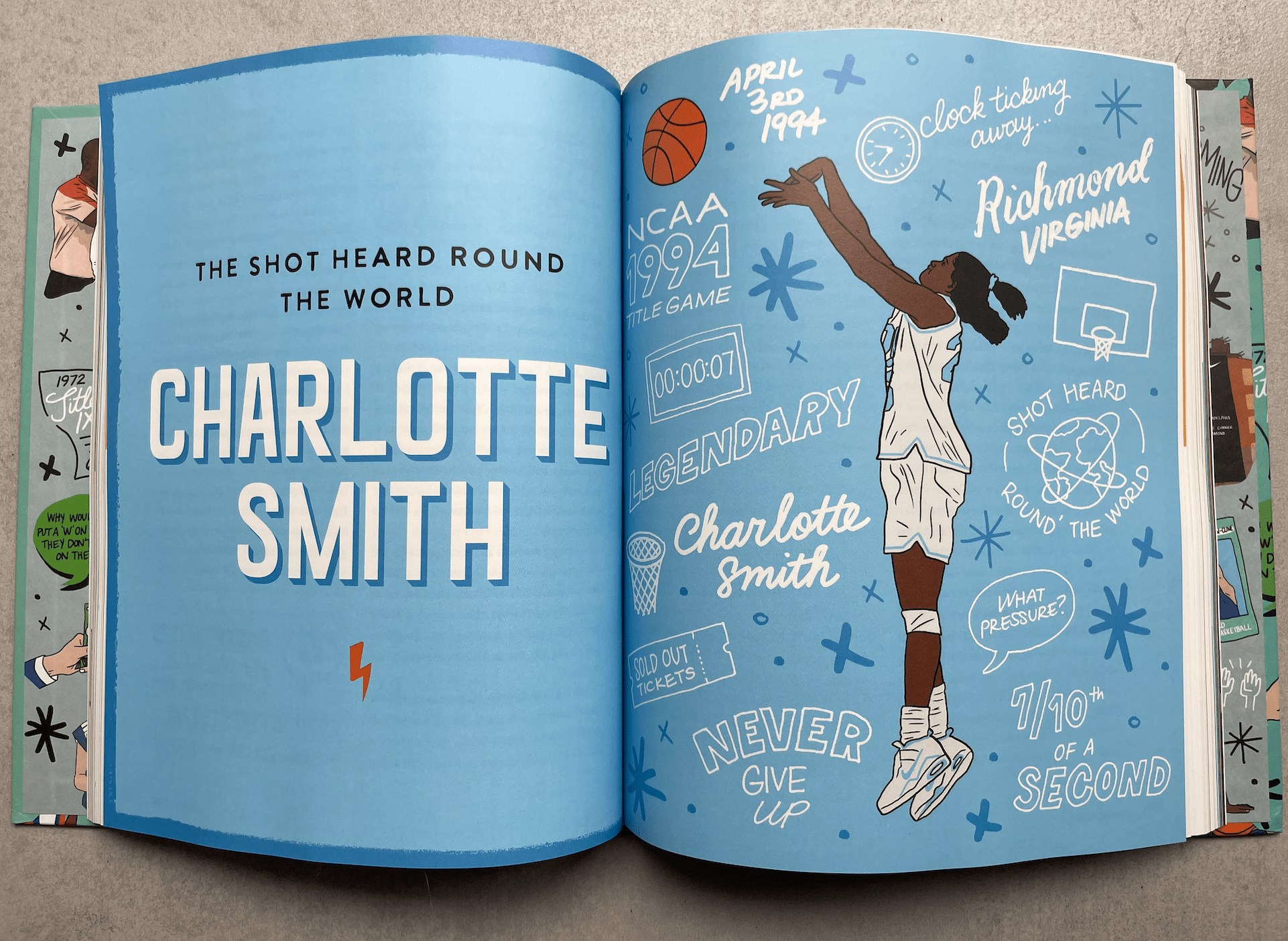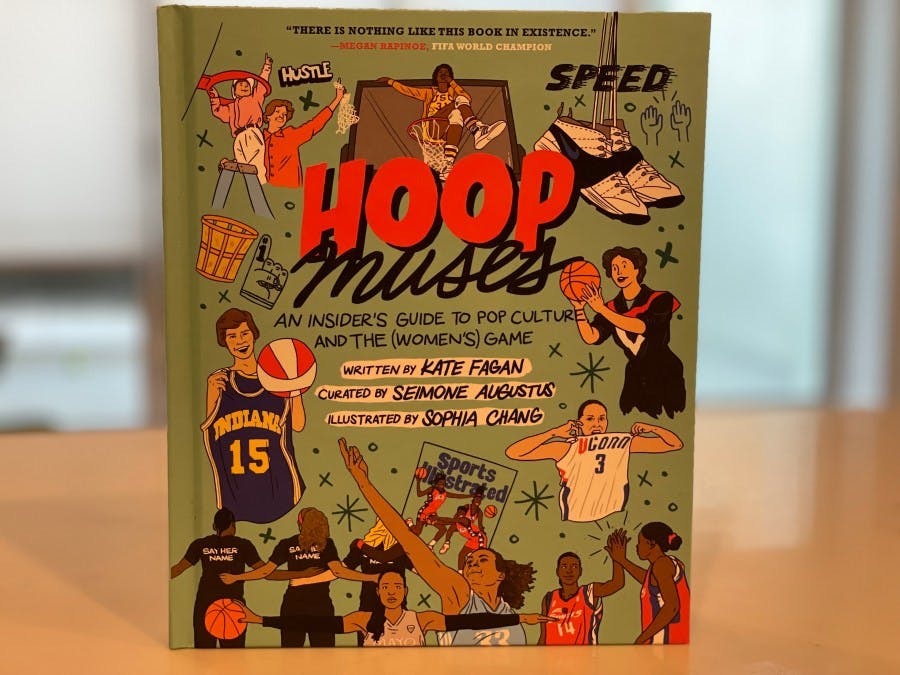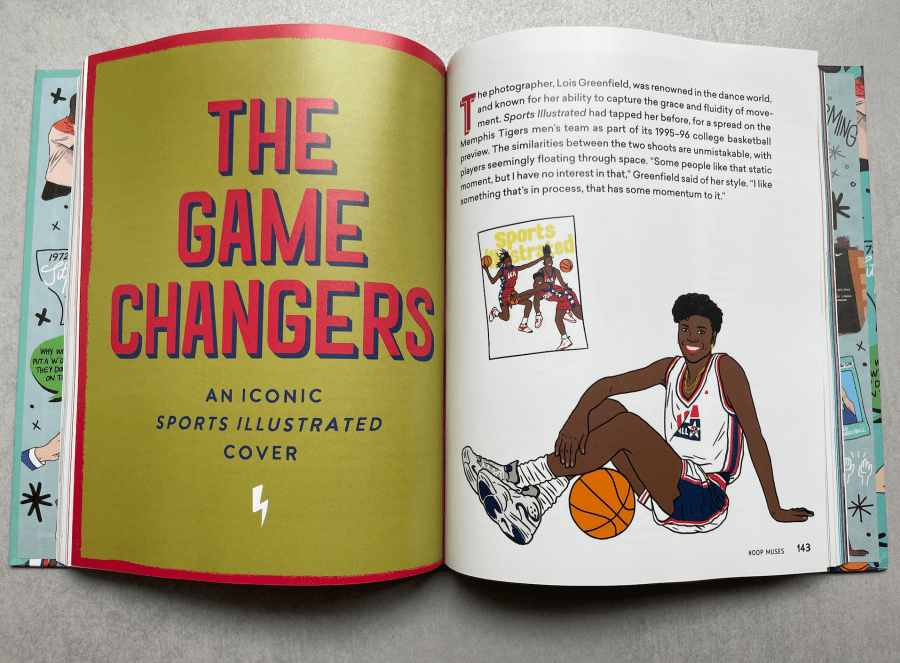We’ve been waiting for something like this! And finally, our hoops dreams have been granted. Hoop Muses: An Insider’s Guide to Pop Culture and the (Women’s) Game by basketball legend Seimone Augustus, longtime sports journalist Kate Fagan, and multimedia designer and illustrator Sophia Chang, is a first-in-kind book that’s a celebration of women’s basketball throughout the ages. We found it to be a fun and funky read that provides all sorts of insights into the women’s game that every hooper should know. So today, we’re going to share a few of our favorite anecdotes and facts from the book, which we received from Twelve Publishing.
What To Expect From Hoop Muses: The Fascinating Past & A Fantastical Future
Hoop Muses is a lively encyclopedia of sorts, featuring mini chapters and stunning illustrations, that starts from the very beginning of basketball in Springfield, 1891. First, you’ll learn the roots of the game (think: the first-ever collegiate game between Stanford and Cal, where men scaled the walls for a peek inside, or, the legend of Chicago’s Club Store Co-Eds, the all-Black barnstorming squad of the 1930s). Then, you’ll see the game grow, and the milestones reached including learning all about Pat Summitt and the early years of the Lady Vols, and Cheryl Miller and Hollywood’s USC Trojans. Plus, you’ll get the inside scoop on infamous women’s hoops moments of lore, such as when Diana Taurasi kissed Seimone Augustus on the cheek during a heated play in a WNBA game. Along the way you’ll also discover the top ten dynamic duos that would have ruled (W)NBA Jam, the movies that should have been, and so much more.
For Seimone, who lives by the “learn something new every day” adage, the opportunity to help educate current generations about those who paved the way was one of the most rewarding aspects of curating the book. “When you start reaching back in time and finding those moments where women had to go through certain things or certain eras for us to get here, it’s a beautiful thing to see,” Seimone said. “We want to give those players their flowers for what they’ve done to help us get where we’re going.”
Interesting Women’s Basketball History From Hoop Muses
Here are a few of our favorite bits and pieces from the book, which is chock full of fascinating stories about women’s hoops.
- When the women’s game debuted at the Olympics in Montreal, in 1976, the US team didn’t even have spots in the Olympic village. All twelve ended up staying in a single two-bedroom apartment with bunk beds in two rooms.
- Marian Washington and Colleen Bower were the first Black players to compete for Team USA, at the 1971 FIBA World Championships.
- The Women’s Professional Basketball League (WBL) was launched in 1978 with eight franchises, each paying a $50,000 entrance fee including the Chicago Hustle, Houston Angels, Iowa Comets, Milwaukee Does, Minnesota Fillies, New Jersey Gems, New York Stars, and Dayton Rockettes. Brenda Chapman was the WBL’s leading scorer in its inaugural season, while Rita Easterling was the MVP.
- We thought this was interesting, given the upcoming prioritization rule implementation: Nancy Lieberman never played overseas. Instead she stayed around the game in the US by playing for the Dallas Diamonds and the Women’s American Basketball Association, and in 1988 she played for the Harlem Globetrotters. (Lynette Woodward was the first woman to play for the Globetrotters.) In 2015, the Sacramento Kings hired her as an assistant coach, and in 2018 she was hired to coach the Power in the BIG3.
- From 1971 to 1982, the AIAW exited to govern women’s sports. After the passage of Title IX, membership in the AIAW exploded, with nearly 1,000 schools at its peak. The AIAW organized women’s college sports in the same way that the National Collegiate Athletic Association (NCAA) oversaw men’s sports. In fact, the NCAA initially wanted nothing to do with women’s sports, and even raised money to file lawsuits against Title IX, attempting to limit the protections guaranteed by its passage. But after a decade of funding, the NCAA realized Title IX was here to stay. Rather than allowing the AIAW, run by women, to govern women’s sports, the NCAA made a move to gain power and control. At the 1981 national meeting, NCAA schools held a contentious vote. Should the NCAA sponsor Division 1 women’s championships? If the motion passed, the AIAW would effectively be killer. The motion was at first defeated by one vote, but another vote was called, some lobbying took place, the motion was passed and the NCAA launched into women’s sports. For the 1981-82 school year, member institutions could compete in both. But by 1982, it was one or the other. By 1983, the AIAW ceased to exist.
- We loved this quote from the only person to win the Naismith Award as both a player and a coach, Dawn Staley, “Basketball is my only fun. Nothing else ever interested me.”
- UCONN hired Geno Auriemma in 1985, and had their first-ever undefeated season and NCAA title in 1994-95.
- Teresa Edwards played in five Olympics, winning four gold medals, and for the ’96 Olympics she was selected to read the athlete’s oath at the opening ceremonies. So she spent the morning of the ceremony traveling around the city with President Bill Clinton and family. “I was just trying to keep up with him and not get in the Secret Service’s way.” she said.
- All hoopers know “we got next” means you’ve got a squad, and you’re ready to take on the winners. The marketing team behind the launch of the WNBA decided to turn this idea into the league’s first-ever slogan. On April 24, 1996 this vision was unveiled in a thirty-second spot on NBC. Learn more about WNBA history here.
- The ABL launched in 1997 with eight teams. The American Basketball League purposely omitted “women” from its title. “Why would we put a W on there? They don’t put one on the men,” said legend Sylvia Crawley at the time. The Columbus Quest won both ABL titles. And while the WNBA salary was $15,000 to $50,000, the ABL’s was $40,000 to $100,000 with year-round benefits. Even though most fans agreed that the ABL’s talent pool was deeper and quality of play stronger, the ABL couldn’t match the WNBA’s deep pockets and its TV network and sponsorship connections.
- The top five all-time NCA scorers include Kelsey Plum (3,527); Kelsey Mitchell (3,402); Jackie Stiles (3,393); Brittney Griner (3,283); and Patricia Hoskins (3,122).
- On August 4, 2020, mid-way through President Barack Obama’s second term, Obama and his youngest daughter, Sasha, sat court side to watch the Washington Mystics play the Tulsa Shock. For generations, presidents have made a point to attend important sports events, from the World Series to the Olympics. This was the first time a sitting American president attended a WNBA game.
Hoop Muses does a great job shedding light on our game. And Kate makes an astute observation in the book, “If, as fans, we agree upon the stakes and know at least one storyline, any game will thrill us.” And by us, she really means everyone. Which is just one of the many reasons why it’s so critical these stories are shared! To learn everything you need to know about the history of the game we love, check out Hoop Muses.
Discover even more of the best women’s basketball books here.


